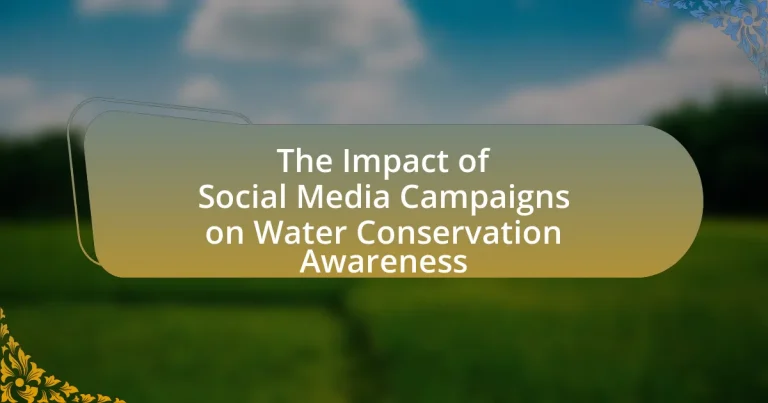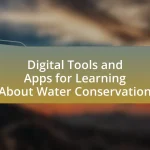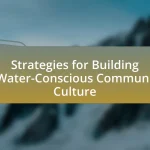The article examines the impact of social media campaigns on water conservation awareness, highlighting how these initiatives effectively reach diverse audiences and promote sustainable practices. It discusses various strategies employed in these campaigns, such as storytelling, influencer partnerships, and interactive content, which enhance engagement and drive behavioral change. The article also emphasizes the importance of visuals and community involvement in amplifying messages, while addressing the challenges faced by influencers in promoting water conservation. Additionally, it outlines measurable outcomes and best practices for evaluating and improving the effectiveness of these campaigns, ultimately underscoring the critical role of social media in fostering awareness and action towards water conservation.

What is the impact of social media campaigns on water conservation awareness?
Social media campaigns significantly enhance water conservation awareness by reaching a broad audience and facilitating engagement. These campaigns utilize platforms like Facebook, Twitter, and Instagram to disseminate information, share success stories, and promote sustainable practices. For instance, a study by the University of California found that social media initiatives increased public awareness of water-saving techniques by 30% within targeted communities. Additionally, interactive content, such as challenges and hashtags, encourages user participation, further amplifying the message. This combination of information dissemination and community engagement effectively raises awareness and promotes behavioral change regarding water conservation.
How do social media campaigns raise awareness about water conservation?
Social media campaigns raise awareness about water conservation by leveraging platforms to disseminate information, engage audiences, and promote actionable behaviors. These campaigns utilize visually compelling content, such as infographics and videos, to highlight the importance of water conservation and the impact of water scarcity. For example, the “Save Water” campaign on Instagram reached millions, showcasing statistics that indicate that nearly 1.1 billion people lack access to clean water, thereby emphasizing the urgency of the issue. Additionally, interactive elements like challenges and hashtags encourage user participation, fostering a community of advocates who share their own water-saving tips and experiences. This participatory approach not only amplifies the message but also creates a sense of collective responsibility, making water conservation a shared goal among users.
What strategies are commonly used in these campaigns?
Social media campaigns focused on water conservation commonly utilize strategies such as storytelling, influencer partnerships, and interactive content. Storytelling engages audiences by sharing personal experiences and impactful narratives related to water conservation, making the issue relatable and urgent. Influencer partnerships leverage the reach and credibility of popular figures to amplify the message, as seen in campaigns where influencers promote water-saving practices to their followers. Interactive content, such as quizzes and challenges, encourages user participation and fosters community engagement, effectively raising awareness and prompting action. These strategies have been shown to increase engagement rates and drive behavioral change, as evidenced by studies indicating that campaigns using storytelling can boost message retention by up to 65%.
How do visuals and storytelling enhance campaign effectiveness?
Visuals and storytelling significantly enhance campaign effectiveness by increasing engagement and retention of information. Research indicates that people process visuals 60,000 times faster than text, making images a powerful tool for capturing attention. Additionally, storytelling creates emotional connections, which can lead to a 22 times increase in recall compared to facts alone. For instance, campaigns that incorporate compelling narratives about water conservation, paired with striking visuals, can motivate audiences to take action, as evidenced by the success of the “Save Water” campaign, which utilized personal stories and impactful imagery to raise awareness and drive behavioral change.
Why is water conservation awareness important?
Water conservation awareness is important because it promotes sustainable water use and helps mitigate the effects of water scarcity. Increased awareness leads to behavioral changes that reduce water waste, which is crucial as global water demand is projected to exceed supply by 40% by 2030, according to the United Nations. This awareness also fosters community engagement and encourages individuals to participate in conservation efforts, ultimately contributing to the preservation of vital water resources for future generations.
What are the environmental benefits of increased water conservation awareness?
Increased water conservation awareness leads to significant environmental benefits, including reduced water scarcity and improved ecosystem health. When individuals and communities recognize the importance of conserving water, they tend to adopt practices that lower water consumption, which directly alleviates pressure on freshwater resources. For instance, a study by the United Nations indicates that effective water conservation can reduce global water demand by up to 30% by 2030, thereby preserving vital habitats and maintaining biodiversity. Additionally, less water extraction from rivers and aquifers helps sustain aquatic ecosystems, which are crucial for various species and overall environmental balance.
How does water conservation impact local communities?
Water conservation positively impacts local communities by ensuring sustainable water supply, which is essential for agriculture, drinking, and sanitation. When communities engage in water conservation practices, they reduce the strain on local water resources, leading to improved water quality and availability. For instance, a study by the American Water Works Association found that communities implementing water-saving measures can reduce water usage by up to 30%, which directly benefits local ecosystems and enhances resilience against droughts. This sustainable management fosters community well-being, economic stability, and environmental health, demonstrating the critical role of water conservation in supporting local populations.
What role do influencers play in social media campaigns for water conservation?
Influencers play a crucial role in social media campaigns for water conservation by leveraging their reach and credibility to raise awareness and promote sustainable practices. They engage their followers through informative content, personal stories, and actionable tips, effectively translating complex environmental issues into relatable messages. For instance, a study by the University of Southern California found that social media influencers can increase engagement rates by up to 60% when discussing environmental topics, demonstrating their ability to mobilize audiences towards water-saving behaviors.
How do influencers affect audience engagement and behavior change?
Influencers significantly enhance audience engagement and drive behavior change by leveraging their credibility and relatability. Their ability to create authentic connections with followers fosters trust, which is crucial for motivating individuals to adopt new behaviors, such as water conservation practices. Research indicates that 70% of teenagers trust influencers more than traditional celebrities, highlighting their impact on shaping opinions and actions. Additionally, campaigns featuring influencers can increase engagement rates by up to 10 times compared to standard marketing efforts, demonstrating their effectiveness in promoting awareness and encouraging sustainable behaviors.
What are the challenges faced by influencers in promoting water conservation?
Influencers face several challenges in promoting water conservation, primarily including audience engagement, misinformation, and the complexity of the issue. Engaging audiences can be difficult as many individuals may not prioritize water conservation, viewing it as less urgent compared to other environmental issues. Misinformation surrounding water usage and conservation methods can also hinder effective communication, as influencers must combat false narratives that may confuse their followers. Additionally, the complexity of water conservation strategies can make it challenging for influencers to convey clear, actionable steps, leading to potential disengagement from their audience. These challenges are significant as they directly impact the effectiveness of social media campaigns aimed at raising awareness about water conservation.
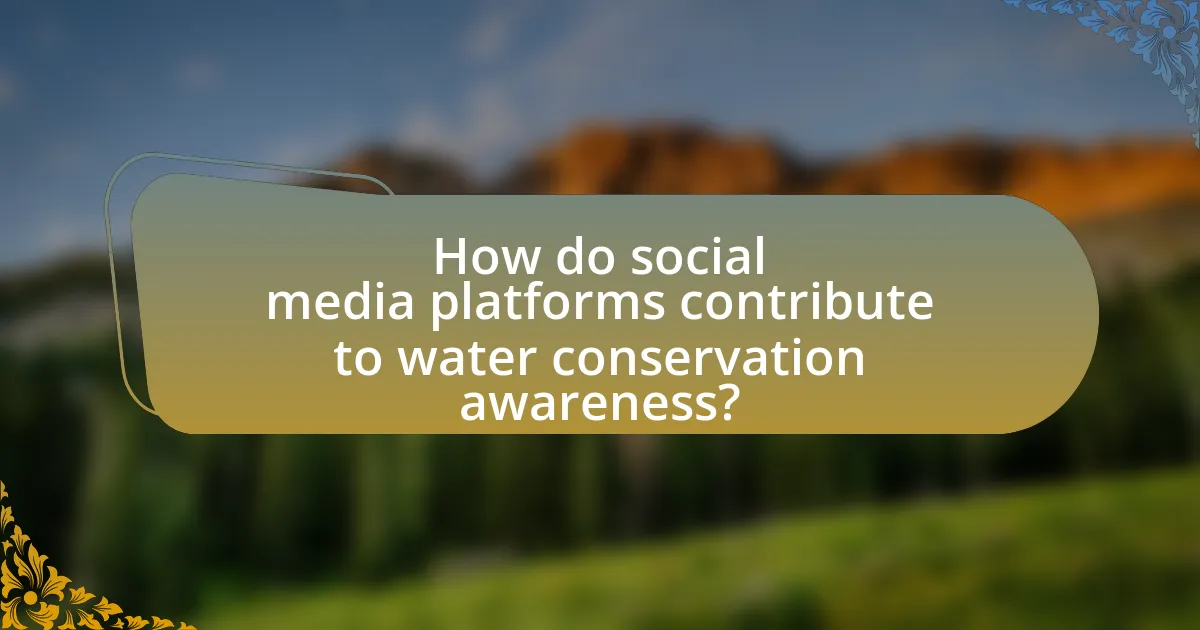
How do social media platforms contribute to water conservation awareness?
Social media platforms significantly contribute to water conservation awareness by facilitating the rapid dissemination of information and engaging communities in discussions about water-related issues. These platforms enable organizations and individuals to share educational content, success stories, and practical tips for conserving water, reaching a global audience instantly. For instance, campaigns like #WorldWaterDay on Twitter and Instagram have successfully raised awareness about water scarcity, engaging millions of users and prompting them to take action. According to a study by the Pew Research Center, 69% of adults in the U.S. use social media, making it a powerful tool for spreading awareness and mobilizing support for conservation efforts.
What features of social media platforms facilitate awareness campaigns?
Social media platforms facilitate awareness campaigns through features such as targeted advertising, shareability, and real-time engagement. Targeted advertising allows organizations to reach specific demographics, increasing the likelihood of engaging individuals who are most likely to support water conservation efforts. Shareability enables users to easily disseminate content, amplifying the campaign’s reach; for instance, a study by the Pew Research Center found that 70% of social media users share content to raise awareness about issues they care about. Real-time engagement fosters interaction between organizations and the audience, allowing for immediate feedback and community building, which is crucial for sustaining interest in water conservation initiatives.
How do hashtags and trends amplify campaign reach?
Hashtags and trends amplify campaign reach by increasing visibility and engagement across social media platforms. When users incorporate relevant hashtags into their posts, they categorize content, making it discoverable to a broader audience beyond their immediate followers. For instance, a study by Pew Research Center found that posts with hashtags receive 12.6% more engagement than those without. Additionally, trending topics attract attention, as users often explore these discussions, leading to higher interaction rates. This phenomenon allows campaigns focused on water conservation to reach diverse demographics, fostering greater awareness and participation in conservation efforts.
What role do user-generated content and community engagement play?
User-generated content and community engagement are crucial in enhancing awareness and participation in water conservation efforts through social media campaigns. User-generated content, such as photos, videos, and testimonials, fosters authenticity and relatability, encouraging individuals to share their own experiences and practices related to water conservation. This shared content can amplify the reach of conservation messages, as seen in campaigns like the #SaveWater initiative, which generated significant user participation and awareness.
Community engagement further strengthens these efforts by creating a sense of belonging and collective responsibility among participants. Engaged communities are more likely to mobilize for local conservation initiatives, as evidenced by studies showing that social media interactions can lead to increased community action and support for environmental causes. For instance, a report by the Pew Research Center found that 69% of social media users believe that these platforms help them connect with others who share similar interests, including environmental issues. This connection can lead to collaborative efforts that enhance the effectiveness of water conservation campaigns.
How do different demographics respond to water conservation campaigns on social media?
Different demographics respond to water conservation campaigns on social media in varied ways, influenced by factors such as age, education, and geographic location. For instance, younger individuals, particularly those aged 18-34, tend to engage more actively with social media campaigns, often sharing content and participating in discussions, as evidenced by a study from the Pew Research Center which found that 90% of this age group uses social media. In contrast, older demographics, such as those over 50, may show lower engagement levels but often respond positively to informative content that emphasizes the long-term benefits of water conservation. Additionally, individuals with higher education levels are more likely to support and participate in these campaigns, as research from the Journal of Environmental Psychology indicates that education correlates with environmental awareness and action. Geographic factors also play a role; urban residents may respond differently than rural residents due to varying levels of water scarcity and access to resources. Overall, understanding these demographic differences is crucial for tailoring effective water conservation campaigns on social media.
What age groups are most engaged with these campaigns?
The age groups most engaged with water conservation awareness campaigns on social media are typically 18 to 34 years old. This demographic shows higher interaction rates due to their frequent use of social media platforms and greater environmental consciousness. Research indicates that individuals in this age range are more likely to participate in online discussions and share content related to sustainability, as evidenced by a study from the Pew Research Center, which found that 70% of young adults actively engage with environmental topics online.
How do cultural factors influence responses to water conservation messages?
Cultural factors significantly influence responses to water conservation messages by shaping individuals’ values, beliefs, and behaviors regarding environmental stewardship. For instance, communities with strong collectivist cultures may respond more positively to messages emphasizing communal responsibility and collective action in water conservation, as seen in studies highlighting the effectiveness of community-based initiatives in such contexts. Conversely, individualistic cultures may prioritize personal benefits and self-interest, leading to a different reception of conservation messages that focus on individual actions and rewards. Research conducted by the University of California found that culturally tailored messaging increases engagement and compliance with water conservation efforts, demonstrating that understanding cultural nuances is crucial for effective communication in social media campaigns aimed at raising awareness.
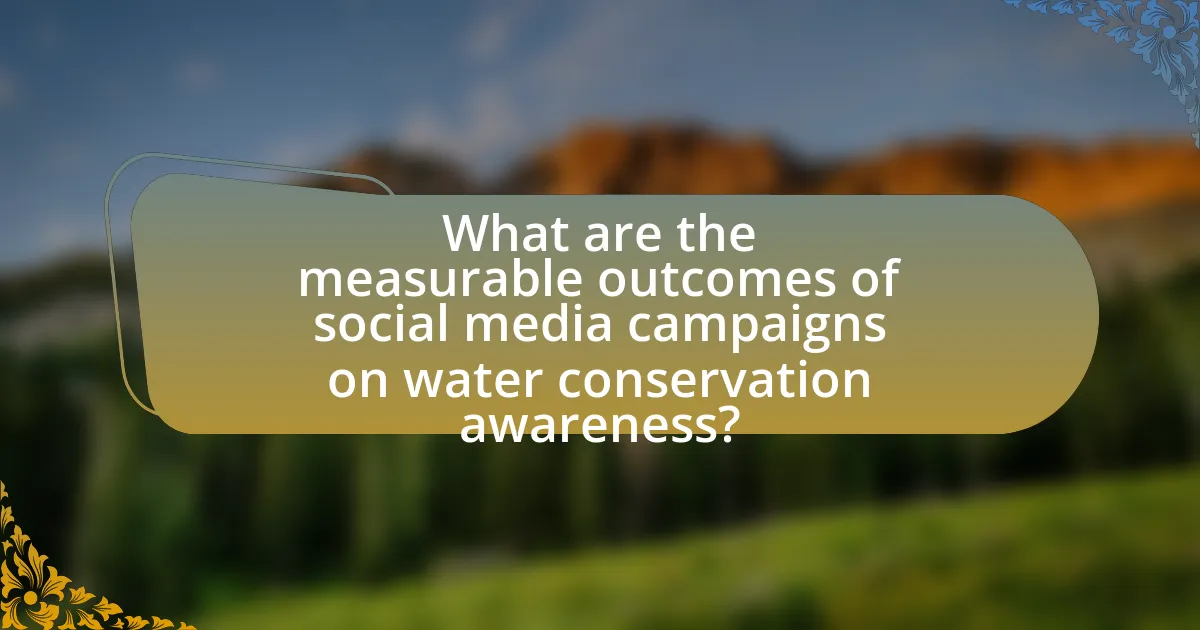
What are the measurable outcomes of social media campaigns on water conservation awareness?
Measurable outcomes of social media campaigns on water conservation awareness include increased engagement metrics, such as likes, shares, and comments, which indicate heightened public interest. For instance, a study by the Water Research Foundation found that campaigns utilizing platforms like Facebook and Twitter led to a 30% increase in user engagement regarding water-saving tips. Additionally, surveys conducted post-campaign often reveal a significant rise in awareness levels, with 70% of respondents reporting improved knowledge about water conservation practices. Furthermore, tracking website traffic to conservation resources linked from social media can show a direct correlation, with some campaigns achieving a 50% increase in visits to educational content. These metrics collectively demonstrate the effectiveness of social media in promoting water conservation awareness.
How can the effectiveness of these campaigns be evaluated?
The effectiveness of social media campaigns on water conservation awareness can be evaluated through metrics such as engagement rates, reach, and conversion rates. Engagement rates, which include likes, shares, and comments, indicate how well the content resonates with the audience. Reach measures the total number of unique users who see the campaign, providing insight into its visibility. Conversion rates assess the percentage of users who take a desired action, such as signing a pledge or sharing information about water conservation. According to a study by the Pew Research Center, social media campaigns that effectively engage users can lead to a 30% increase in awareness and action regarding environmental issues, demonstrating the potential impact of these metrics on evaluating campaign effectiveness.
What metrics are used to assess engagement and awareness levels?
Metrics used to assess engagement and awareness levels include reach, impressions, engagement rate, click-through rate (CTR), and conversion rate. Reach measures the total number of unique users who see the content, while impressions indicate how many times the content is displayed, regardless of clicks. Engagement rate, calculated by dividing total interactions (likes, shares, comments) by total followers or reach, reflects how actively users interact with the content. Click-through rate measures the percentage of users who click on a link compared to the total number of users who viewed the content, indicating interest. Conversion rate tracks the percentage of users who take a desired action, such as signing up for a newsletter or making a donation, demonstrating the effectiveness of the campaign in driving specific outcomes. These metrics provide a comprehensive view of how well social media campaigns are performing in raising awareness and engaging the audience regarding water conservation.
How do surveys and feedback contribute to understanding campaign impact?
Surveys and feedback are essential tools for assessing the impact of social media campaigns on water conservation awareness. They provide quantitative and qualitative data that reveal audience perceptions, engagement levels, and behavioral changes resulting from the campaign. For instance, a study by the Water Research Foundation found that 70% of participants reported increased awareness of water conservation practices after engaging with targeted social media content. This data allows campaign organizers to evaluate the effectiveness of their messaging and identify areas for improvement, ensuring that future campaigns are more impactful.
What best practices can enhance the effectiveness of social media campaigns for water conservation?
To enhance the effectiveness of social media campaigns for water conservation, organizations should focus on creating engaging, informative content that resonates with their audience. Engaging visuals, such as infographics and videos, can significantly increase user interaction; studies show that posts with images receive 94% more views than those without. Additionally, utilizing storytelling techniques to share personal experiences related to water conservation can foster emotional connections and motivate action.
Incorporating clear calls-to-action encourages followers to participate in conservation efforts, such as pledging to reduce water usage or sharing their own tips. Collaborating with influencers who are passionate about environmental issues can also expand reach and credibility, as 49% of consumers rely on influencer recommendations for purchasing decisions.
Regularly analyzing engagement metrics allows organizations to refine their strategies based on what resonates most with their audience, ensuring continuous improvement in campaign effectiveness.
What are the key elements of a successful water conservation campaign on social media?
A successful water conservation campaign on social media includes clear messaging, engaging visuals, community involvement, and measurable goals. Clear messaging ensures that the audience understands the importance of water conservation, while engaging visuals capture attention and enhance retention of information. Community involvement fosters a sense of ownership and encourages sharing, amplifying the campaign’s reach. Measurable goals allow for tracking progress and demonstrating impact, which can motivate further participation. For instance, campaigns that utilize infographics showing water usage statistics have been shown to increase awareness and engagement by up to 50%.
How can organizations leverage data to improve future campaigns?
Organizations can leverage data to improve future campaigns by analyzing past campaign performance metrics to identify successful strategies and areas for enhancement. By utilizing analytics tools, organizations can track engagement rates, conversion rates, and audience demographics, allowing them to tailor content more effectively. For instance, a study by HubSpot found that companies using data-driven marketing strategies see a 5-8 times higher ROI compared to those that do not. This evidence underscores the importance of data in refining messaging and targeting, ultimately leading to more impactful campaigns in the context of water conservation awareness.
